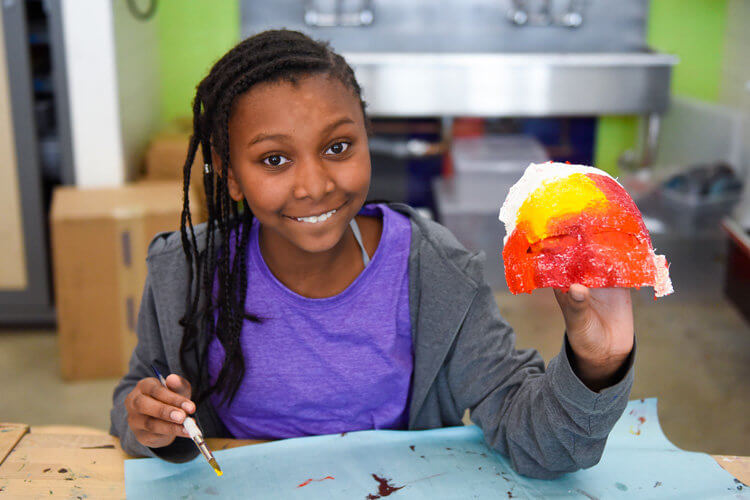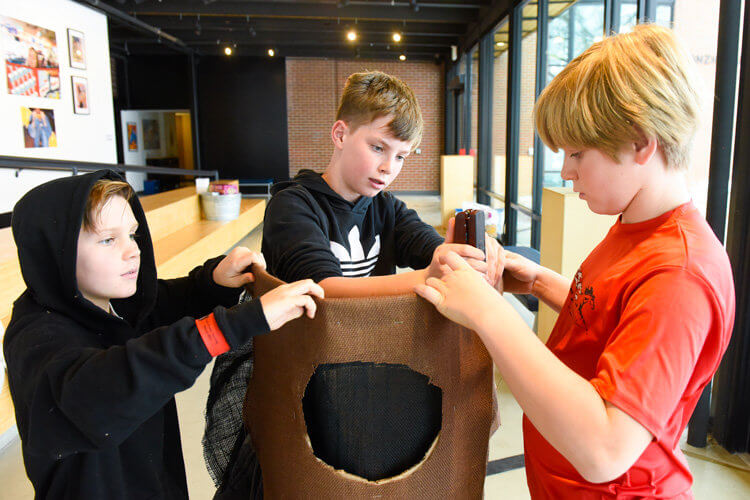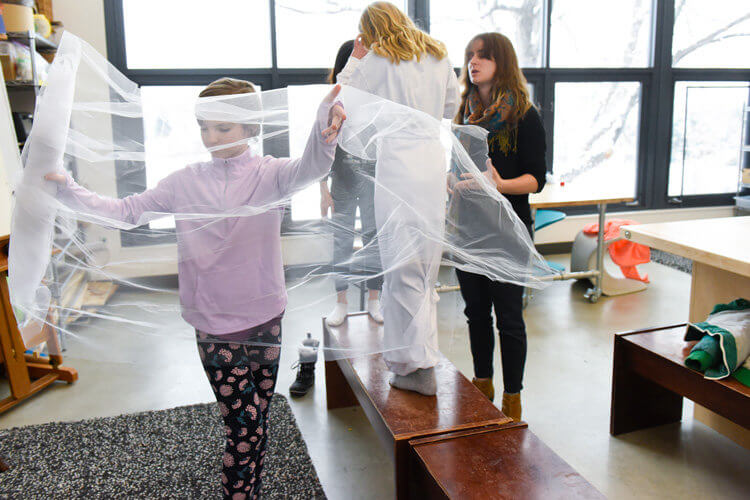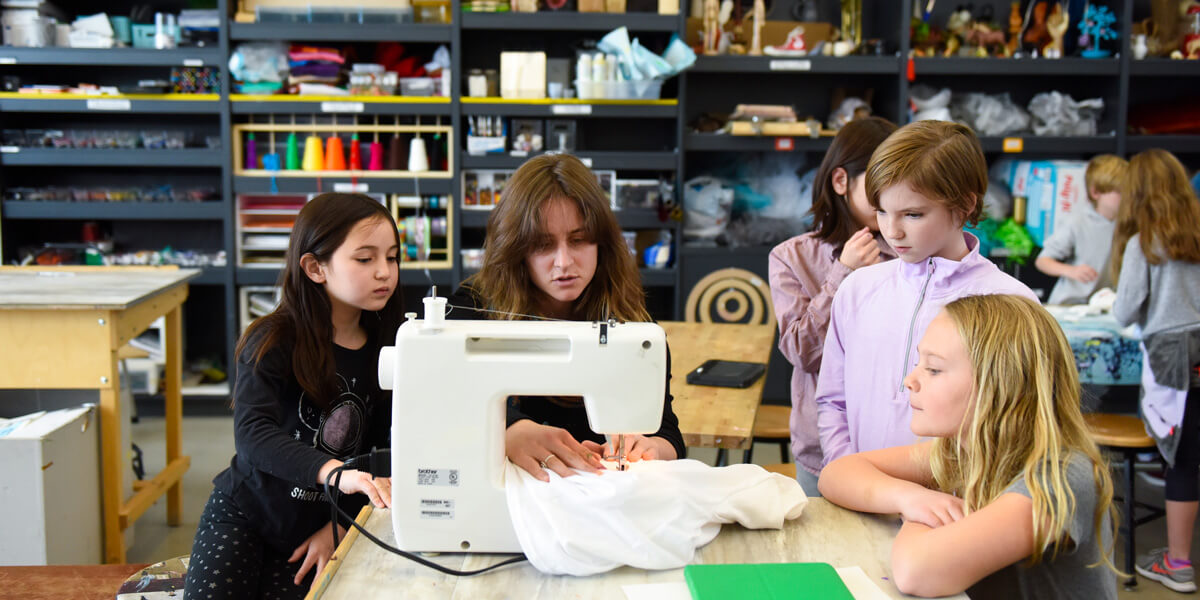What do you remember from art class in elementary school? Odds are, you recall receiving a hand-out of a drawing (a leaf in October, a turkey in November, a snowflake in December, and a flower in May) and your creative experience started and stopped with the colors of crayon you chose.
But if you walk into Stashia Taylor’s Lower School art class at Colorado Academy, you will observe something quite different. Students are gathered in half a dozen small groups. They are busy preparing for a collaborative music and art project—their original play “Elemental Dreams” about earth, water, fire, and wind explored through dream-inspired images, sound, and works of art.
Cooper Martin and Henry Cowperthwaite are part of one group creating artistic masks that performers will wear. Macey MCkean is sewing accessories for a costume and bemoaning that her needle isn’t sharp enough. Keren Laizer and Piper Morris wield paintbrushes as they create props. Evi Sorenson is rolling cardboard to create scenery. Pritika Lingam-Nattamai is sketching, designing a costume and proud to show off the filmy materials she plans to use in its creation.
As for Taylor, there seems to be half of dozen of her as she floats around the room from group to group, helping and demonstrating, but also prompting student to solve their own problems. “What do we need for the cape?” she asks one group. “What material would be best to create movement?”
This is what is known as TAB in action. TAB is the acronym for “Teaching for Artistic Behavior.” Taylor sums up the philosophy simply: “It means students have a choice in how they develop as an artist.”

What is TAB?
Taylor was working as a graphic designer when she started volunteering for a Volunteers for Outdoor Colorado youth program and discovered she had a passion for mentoring and teaching young people. “As an artist, I loved the conceptual development and problem solving with each piece,” she says. “I wanted to help kids discover their own passions.”
She studied a variety of methods for art education with one question in mind: “What is the role of art education in a school today?” She believes that the answer is to understand that different students have different needs from art, and the methodology that best meets those needs can be found in TAB, a concept that originated in Massachusetts classrooms more than four decades ago. Students in TAB programs experience artistic thinking and making through self-direction, and teachers respond to their progress with a flexible curriculum that adapts to their emergent ideas.
“So many people say ‘I’m not an artist, I just can’t draw,’” Taylor says. “But drawing is just one tiny piece of a much larger world of creating. I want to expand on what it means to be an artist or a creator and TAB helps with that.”

TAB in action
What TAB looks like in action varies from day to day. Traditionally, students learning how to paint with watercolors might study a Georgia O’Keeffe painting and then imitate it. But Taylor points out that great artists are pioneers; teaching students only to imitate inhibits that pioneer spirit. When she introduces paint, she gives students a day where they can take time to explore the new medium. Maybe they will paint with a brush— maybe they will paint with a different tool, maybe they will discover an entirely new style. Students share their discoveries and apply newfound techniques unbiased. Only then does Taylor bring contemporary artworks into the classroom for students to evaluate and gain inspiration from.
When sixth grade students explore the techniques of surrealist artists like Dali, Picasso, or Magritte, they start by asking the same questions and playing the same games these pioneer artists used to spark their ideas. “Exquisite Corpse,” in which drawings are created by a group of people with each person unaware of what previous players had created, is a classic game played by Surrealists—and in CA art classes. Students look at the same ideas Surrealists explored about fantasy, reality, and the subconscious. They then develop their own pieces; choosing their media, subject matter, and techniques they want to focus on. “They learn skills and concepts without losing their own style,” Taylor says. “Artists have so many unique ways to create work about things they care about.”

What is artistic behavior?
A TAB-based curriculum outlines specific behaviors, “habits of mind,” that are encouraged no matter what media, content, or subject the artist uses.
- Develop your craft – improve technique, composition, and skill
- Engage and persist – problem solve when you encounter frustrations
- Envision – picture mentally where you are headed
- Express – create a work that conveys an idea, a feeling, or a personal meaning
- Observe – look at the world more closely
- Reflect – talk with others about your work
- Stretch and explore – reach beyond your capacities
- Understand the arts community – interact with other artists and familiar with contemporary art
Taylor points out that these behaviors, while learned in an art studio, cross over to many different disciplines. “Engaging, persisting, reflecting—these are universal skills in an art studio, science lab, sports field,” Taylor says. “Whatever their path is, these skills are universal and in our studio students are encouraged to look at a problem from many angles and envision multiple solutions.”
Taylor’s fifth graders may know nothing about the origins of TAB, but they know what they like about art class and they can’t wait to tell anyone who asks.
Philip Foreman: “In art you get to do what you want to do. That’s so different from math where there is only one right answer and there are instructions on how to find the right answer. Here you do it your way.”
Piper Morris: “Art is where you can do whatever your imagination dreams of.”
Luis Rodriguez: “Art is a place where you can be free.”
Keren Laizer: “I love art. It’s a way for me to relax and express myself. And it’s a place where no one judges your work.”
With TAB, Taylor believes she is setting the foundation for artistic behavior in Lower and Middle School that will continue as students progress. “This is the foundation,” she says. “Students develop their own way of thinking and explore a lot of different media. As they mature creatively, they will have discovered their creative strengths and be able to communicate their incredibly unique perspective.”
